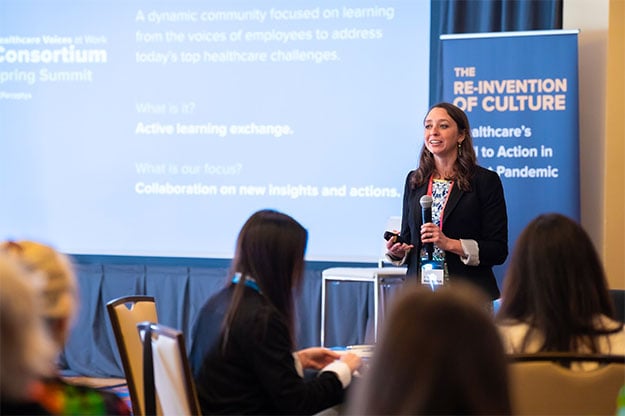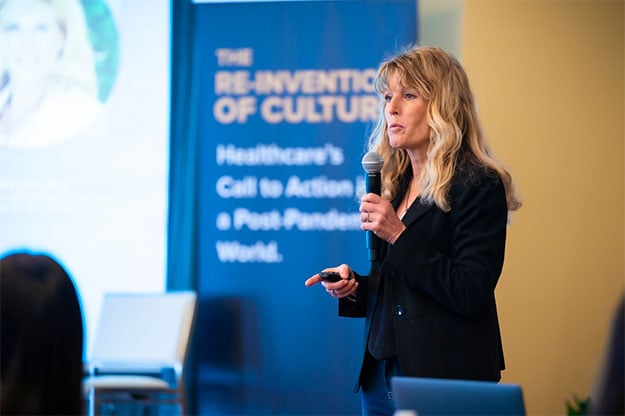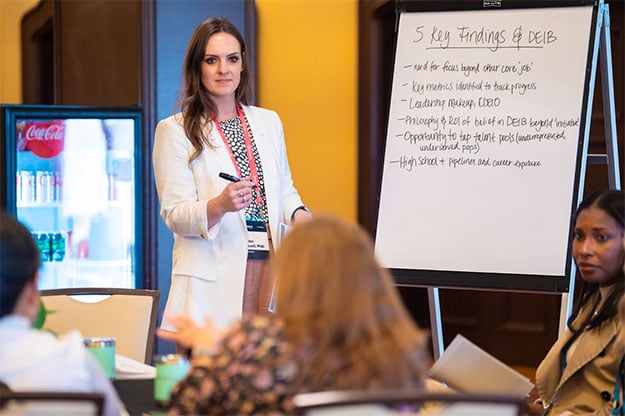"Engaging," "inspiring," "thought-provoking," "useful," and "reassuring" are just a few of the words used by the more than 30 healthcare leaders from 23 diverse organizations to describe their experience at the Healthcare Voices at Work Consortium’s spring summit.

Dr. Lauren Beechly shared data-based insights into the current state of healthcare
The Consortium, a dynamic community focused on learning from employee voices, addresses today's top healthcare challenges through active collaboration, evidence-based insights, and actionable best practices. The spring summit provided an opportunity for healthcare leaders to reflect on progress, examine new research, and share strategies to help both their people and organizations thrive.
Key insights from the summit included:
- Declining engagement and experiences among healthcare workers emphasize the need for continued improvements in staffing, well-being, safety, inclusion, and future optimism.
- The 2.1 million RN shortage in the U.S. can not be overcome with recruitment, reskilling, and retention efforts alone, causing a need for work redesign to also reduce demand.
- Diversity, equity, inclusion, and belonging (DEIB) remains a priority for executives, staffing pressures have forced talent pipeline expansion into more diverse populations, and partnerships with regulatory bodies are needed to ensure current standards also support desired job redesign and DEIB goals.
- Psychological safety not only promotes well-being and DEIB efforts by reducing stress and encouraging diverse voices but it also provides a safe space for frontline staff to provide critical feedback needed in job redesign efforts.
- To address well-being, consider human factors in work redesign, simplify well-being frameworks, conduct more research to better understand the impact of well-being efforts on patient outcomes, and encourage senior leaders to communicate the importance of well-being while modeling supportive behaviors.
A Powerful Call to Action
The summit was a call to action for everyone to contribute ideas, solutions, research, and more to this ever-growing community. This year, the Consortium included another energizing day of research, reflection, and discussion led by the following advisors:
- Dr. Matthew Gosney, VP of Organizational Development and Learning Services, UCHealth
- Dr. Russell Hoffman, VP of Organizational Development and Culture, BJC HealthCare
- Dr. David Gill, VP Culture and Experience, Northwell Health
- Dr. Ekta Vyas, Chief Human Resources Officer, Keck Medicine of USC
The event kicked off with members networking, reconnecting with colleagues, and meeting new leaders seeking to address similar challenges across their organizations.
Declining Engagement and the Need to Reinvent Healthcare Culture
In her presentation, Dr. Lauren Beechly, Director of Healthcare Consulting at Perceptyx, shared data-based insights into the current state of healthcare, emphasizing the Consortium's three priority areas of diversity, equity, inclusion, and belonging (DEIB), safety, and well-being. With historically low operating margins due to rising labor costs, executives are increasingly focused on cost containment, sustainable recruitment and retention strategies, and flexible staffing models. DEIB remains a top priority for chief nursing officers (CNOs), while executives rank well-being and safety as more important in 2023 than in previous years.
Perceptyx's research on engagement over time highlights the urgent need to reinvent healthcare culture. Our study of more than 500 healthcare organizations revealed a decline in engagement over the last six months, causing the improved experiences reported in the summer of 2022 to be short-lived while highlighting five areas with the biggest opportunities to improve the employee experience: staffing, well-being, safety, value voices/inclusion, and future optimism.

Dr. Kathi Enderes shared research and provided a framework for the Consortium’s discussions
Keynote speaker Dr. Kathi Enderes, SVP Research and Global Industry Analyst at The Josh Bersin Company, provided a framework for the Consortium's discussions, highlighting the massive 2.1 million nursing gap in the U.S. by 2025. The Josh Bersin Company's research and 4-R framework suggests that efforts to recruit, retain, and reskill nurses alone will not close the gap, emphasizing the need for work redesign to reduce demand. Additionally, these data reveal the most innovative organizations invest in more roles dedicated to work redesign.
Key learnings on DEIB, Safety, and Well-Being
After reviewing data and research, the Consortium workstreams of DEIB, safety, and well-being shared their progress since the first summit last May. DEIB called for member participation to share success stories, while well-being encouraged involvement in future discussions to build a case for well-being within organizations and develop an inventory of best practices for leaders to improve well-being.
Roundtable discussions explored how the research impacts goals, objectives, and strategies for each of the focus areas, shared solutions to advancing each of the focus areas using the 4-R framework, and identified future research priorities for the Consortium to investigate.

Senior consultant Dr. Ellen Lovell records key findings on DEIB from Consortium participants
For DEIB, members discussed expanding the scope of DEIB to include aspects such as neurodiversity and diversity of experiences, leveraging diverse talent pipelines to not only improve diversity but also relieve staffing pressures, and addressing how some regulatory requirements challenge efforts to improve DEIB and limit job redesign opportunities.
DEIB solutions from the Consortium mapped to The Josh Bersin Company’s 4-R framework included:
- Reskill:
- Create accessible career pathways, such as "6 years to 6 figures"
- Offer cultural humility training to acknowledge diverse experiences
- Develop non-traditional career pathways that provide different growth opportunities to meet the career aspirations of different people
- Redesign:
- Assess degree requirements while considering potential conflicts with program/regulation requirements, such as Magnet and BSN
- Collaborate with regulators to reevaluate criteria, supporting work redesign and DEIB goals
- Recruit:
- Intentionally source talent through diverse channels, such as partnering with diverse schools and high schools
- Share examples of an inclusive culture during recruiting to attract talent
- Revamp benefits and total rewards by understanding diverse employee needs and effectively communicating the value of benefit offerings addressing these needs
- Retain:
- Recognize diverse cultures and holidays via executive communications and provide educational information
- Implement floating cultural holidays
- Develop intentional processes, such as scheduling inclusive meetings
- Foster belonging and value for new hires with CEO involvement in orientation
Safety members presented a playbook on psychological safety, created by members from various leading organizations. This extensive resource defines different practices to foster psychological safety, tangible actions of “what good looks like,” and research-based resources to learn more about any specific practice. Discussions about safety included recognizing the connection between psychological safety, DEIB, and well-being, embedding efforts to improve psychological safety within High Reliability (HRO) goals, and addressing communication challenges arising from psychologically unsafe environments that lead to a cycle of turnover and difficulty attracting talent.
Safety solutions from the Consortium mapped to The Josh Bersin Company’s 4-R framework included:
- Reskill:
- Offer safety training through technology-based micro-learning sessions for better engagement and timing
- Provide scripts to foster psychological safety
- Encourage open discussions on job satisfaction, interests, goals, and aspirations to identify reskilling opportunities
- Redesign:
- Implement safe phrases like 'stop the line' or 'see something, say something' to address unsafe situations
- Apply humble inquiry and a "beginner's mind" in work/talent redesign
- Utilize crowdsourcing to involve diverse perspectives in redesign
- Foster psychological safety for open discussions on redesign challenges and change management
- Recruit:
- Highlight examples of employee psychological and physical safety support to attract talent
- Assess leadership candidates on their commitment to psychological safety during interviews
- Retain:
- Share good catches and patient stories to reinforce psychological safety positively
- Encourage senior leaders to actively address safety concerns through direct conversations
- Take action on Culture of Safety survey results to improve “just culture”
In the well-being discussions, participants highlighted all of the research findings negatively impact well-being and the need to consider human factors when redesigning work. Simplified best practice frameworks with clearer definitions were suggested, emphasizing that well-being initiatives should start with senior leaders communicating their importance and modeling supportive behaviors. Participants also encouraged prioritizing initiatives, leveraging existing frameworks for systematic changes, and conducting further research to demonstrate the ROI of well-being, the impact of cognitive load, and the efficacy of various efforts on employee well-being and patient outcomes.
Well-being solutions from the Consortium mapped to The Josh Bersin Company’s 4-R framework included:
- Reskill:
- Implement a Culture Influencer program to promote change and alleviate leader workload
- Apply patient techniques and existing organizational frameworks to employee well-being initiatives
- Encourage career mobility to improve financial well-being
- Redesign:
- Redesign work with a holistic understanding of the effect the work has on employee well-being
- Incorporate mission and values in meetings
- Create Zen Dens or quiet rooms for relaxation
- Establish cross-functional Care Collaboratives for streamlined initiatives
- Redesign administrative tasks to reduce stress and introduce flexibility
- Begin meetings with music to set a positive tone
- Recruit:
- Invest in lifestyle spending accounts for financial stress relief
- Organize and make existing resources easily accessible
- Highlight well-being offerings in the Employee Value Proposition (EVP)
- Utilize Employee Resource Groups (ERGs) to foster connection and community
- Offer music and art therapy for patients and employees
- Retain:
- Implement a stress first aid framework for proactive support
- Use "color checking" to create a common language around well-being and signal when help is needed
- Encourage HR check-ins focused on well-being
- Provide "We Flourish" communications and daily microlearning activities for well-being improvement
Get Involved with the Healthcare Voices at Work Consortium
Dr. David Gill of Northwell Health concluded the summit by urging healthcare leaders to get involved in this active exchange, sharing ideas, solutions, questions, and research to continuously improve the industry. Collaboration is essential to uncover new insights and effective actions for addressing today's top healthcare challenges. By working together, this community provides a valuable network to help people and organizations thrive. If you are interested in becoming a member or contributing to the Healthcare Voices at Work Consortium, you can reach out here.
Perceptyx helps healthcare organizations create listening programs that will facilitate best practices in employee experience and engagement. From crowdsourcing insights to developing always-on listening models, we provide organizations with crucial resources to help your people and organization thrive. To learn more, schedule a demo today.
